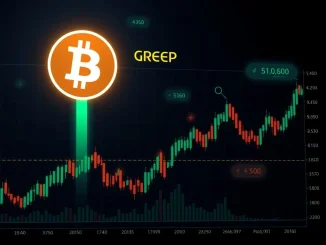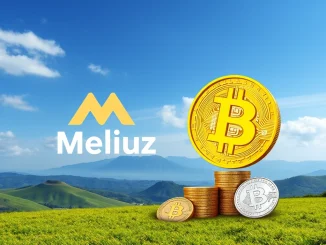
Could Bitcoin one day sit alongside gold and foreign currencies as a key holding for the United States? A recent report from global financial giant Morgan Stanley suggests this isn’t just a wild dream anymore. With a market capitalization reaching significant levels, Bitcoin is starting to enter conversations previously reserved for traditional assets. But don’t pack your bags for a Bitcoin-backed future just yet; significant hurdles remain.
Morgan Stanley’s Take on Bitcoin as a U.S. Reserve Asset
According to a report from Morgan Stanley, the sheer size of Bitcoin’s market cap – recently hovering around $1.87 trillion – is substantial enough for it to be considered within the realm of potential U.S. reserve assets. This marks a notable shift in perspective from a major Wall Street institution, acknowledging Bitcoin’s growing financial footprint. Traditional reserve assets are held by central banks to manage currency stability, facilitate international trade, and maintain economic confidence. The idea that Bitcoin could potentially serve a similar role, even partially, highlights its maturation as an asset class.
The report even went further, providing a hypothetical scenario. It suggested that a U.S. holding of 12–17% of Bitcoin’s total supply would align with the proportion of traditional reserve assets like gold or specific foreign currencies that nations typically hold. This isn’t a prediction or a recommendation, but rather an illustration of the scale required for Bitcoin to fit within existing reserve frameworks. It gives concrete numbers to the abstract concept of Bitcoin integration into national finance.
Understanding Bitcoin Volatility: The Major Hurdle
While the market cap makes Bitcoin ‘sizable,’ Morgan Stanley was clear about the primary obstacle: high Bitcoin volatility. Reserve assets are typically valued for their stability and reliability in times of economic uncertainty. Bitcoin, while offering potential long-term growth, is notorious for its rapid and often unpredictable price swings. This volatility makes it challenging for a central bank to rely on it as a stable store of value or a predictable tool for economic management.
Think about it: a significant percentage of a nation’s reserves could fluctuate dramatically in value overnight due to market sentiment, regulatory news, or macroeconomic shifts. This inherent risk profile is fundamentally different from traditional reserve assets like gold or major fiat currencies, which, while not immune to fluctuations, generally exhibit less extreme short-term price movements. For Bitcoin to truly qualify as a standard reserve asset, its volatility would likely need to decrease significantly over time, a prospect that depends on market maturity, increased liquidity, and broader institutional adoption.
The Strategic Bitcoin Reserve Debate
The Morgan Stanley report comes at a time when there’s an ongoing, albeit nascent, debate surrounding the potential creation of a Strategic Bitcoin Reserve in the U.S. This concept, separate from the traditional Treasury reserves, envisions the government holding a strategic stash of Bitcoin, perhaps for future economic leverage or as a hedge against unforeseen circumstances. The idea draws parallels to the Strategic Petroleum Reserve, which holds oil to mitigate supply disruptions.
However, establishing a Strategic Bitcoin Reserve faces considerable challenges:
- Political Opposition: There’s significant skepticism and opposition from lawmakers on both sides of the aisle regarding government involvement in volatile cryptocurrency markets.
- International Skepticism: Other nations may view such a move with suspicion, potentially impacting international financial relations.
- Technical & Security Issues: Managing and securing a massive government holding of Bitcoin presents unprecedented technical and security challenges.
- Purpose Clarity: The exact strategic purpose and operational plan for such a reserve remain ill-defined and subject to debate.
Morgan Stanley’s analysis adds a layer of institutional validation to the conversation about Bitcoin’s potential role in national finance, even as it highlights the practical difficulties.
What Does This Mean for Bitcoin’s Future?
A report like this from Morgan Stanley doesn’t mean the U.S. Treasury is buying Bitcoin tomorrow. What it *does* signal is the increasing recognition of Bitcoin’s economic significance within traditional finance. Major institutions are analyzing its potential, weighing its benefits against its risks, and discussing how it might fit into the existing global financial architecture.
For Bitcoin enthusiasts, this is a positive sign of mainstream acceptance and maturation. For policymakers and economists, it’s a prompt to seriously consider the implications of a decentralized, digital asset potentially playing a role previously held only by sovereign currencies and commodities. The journey from niche digital asset to potential U.S. reserve asset is long and fraught with challenges, but the conversation is undeniably gaining momentum.
Conclusion: A Step Towards Legitimacy, But Volatility Lingers
Morgan Stanley’s assessment that Bitcoin’s market cap is sufficient for it to be *considered* a U.S. reserve asset is a landmark moment. It elevates Bitcoin into a discussion previously unthinkable for a decentralized digital currency. While the report clearly identifies Bitcoin volatility as a major barrier, the mere fact that a prominent global bank is analyzing hypothetical government holdings and discussing a Strategic Bitcoin Reserve underscores the asset’s growing legitimacy in the eyes of traditional finance. The path forward is uncertain, marked by political hurdles and the inherent nature of crypto markets, but reports like this confirm that Bitcoin is no longer just a fringe asset; it’s a significant player demanding serious consideration on the global financial stage.



